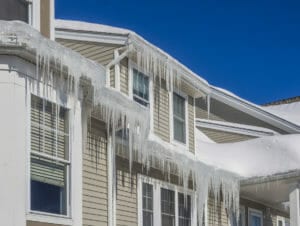Ice dams can present a problem for your home any time the mercury dips to below freezing for an extended period of time and snow or ice are visible on your roof. If you look up and see icicles forming from your gutters or roof eaves, that’s a sign of potential ice dams also forming.
When snow and ice on your home’s roof melts and flows toward the gutters, it may be prevented from going down the gutters and to the down spouts because the gutters are clogged. Instead, this water will start to refreeze when it reaches the edges of the roof where no attic heat is present. This can build an ice dam.
When water continues to flow down the roof from melting snow and ice and gets blocked by an ice dam, it will start to pool up and can cause damage to the roof and also leak down into the attic, down walls and through the ceiling. Depending on the condition of your roof, a large ice dam can even lead to a collapsed roof.
Are Ice Dams Covered By My Greensboro Homeowners Insurance Policy
Your Greensboro homeowners insurance policy most likely covers ice dam damage, even though the term “ice dam” may not be used in the policy. It’s standard for homeowners insurance to pay for losses resulting from “weight of ice and snow.” Payment should include damage to both your home’s structure and any of your personal possessions that are damaged by leaking water or a collapsed roof.
Bear in mind that coverage may not extend to certain structures on your property such as fences, patios or swimming pools. Since every homeowner’s policy may be slightly unique, it’s best to read through your policy for an exact determination on ice and snow damage and to consult with your agent if you have questions.
Ice Dam Removal
While your insurance will likely pay for damage caused by an ice dam and probably remove the ice dam that’s caused the damage, they’ll usually not pay for ice dam removal if it hasn’t yet caused a loss.
Before making a claim to your insurer for ice dam damage you should carefully consider the proposed cost of fixing the damage and removing the ice dam versus the cost of your policy’s deductible. If damage costs are close to the deductible amount, you’ll probably want to skip the claim.

